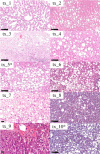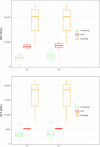Viability assessment and transplantation of fatty liver grafts using end-ischemic normothermic machine perfusion
- PMID: 36117430
- PMCID: PMC10106107
- DOI: 10.1002/lt.26574
Viability assessment and transplantation of fatty liver grafts using end-ischemic normothermic machine perfusion
Abstract
End-ischemic viability testing by normothermic machine perfusion (NMP) represents an effective strategy to recover liver grafts having initially been discarded for liver transplantation (LT). However, its results in the setting of significant (≥30%) macrovesicular steatosis (MaS) have not been specifically assessed. Prospectively maintained databases at two high-volume LT centers in Northern Italy were searched to identify cases of end-ischemic NMP performed to test the viability of livers with MaS ≥ 30% in the period from January 2019 to January 2022. A total of 14 cases were retrieved, representing 57.9% of NMP and 5.7% of all machine perfusion procedures. Of those patients, 10 (71%) received transplants. Two patients developed primary nonfunction (PNF) and required urgent re-LT, and both were characterized by incomplete or suboptimal lactate clearance during NMP. PNF cases were also characterized by higher perfusate transaminases, lower hepatic artery and portal vein flows at 2 h, and a lack of glucose metabolism in one case. The remaining eight patients showed good liver function (Liver Graft Assessment Following Transplantation risk score, -1.9 [risk, 13.6%]; Early Allograft Failure Simplified Estimation score, -3.7 [risk, 2.6%]) and had a favorable postoperative course. Overall, NMP allowed successful transplantation of 57% of livers with moderate-to-severe MaS. Our findings suggest that prolonged observation (≥6 h) might be required for steatotic livers and that stable lactate clearance is a fundamental prerequisite for their use.
Copyright © 2022 The Author(s). Published by Wolters Kluwer Health, Inc.
Conflict of interest statement
Renato Romagnoli advises for Biotest Italia and consults for Kedrion Biopharma.
Figures




Comment in
-
Salvaging the fatty liver for transplant: is short duration NMP enough?Liver Transpl. 2023 May 1;29(5):465-466. doi: 10.1097/LVT.0000000000000073. Epub 2023 Jan 26. Liver Transpl. 2023. PMID: 36695304 No abstract available.
-
Reply: Viability assessment and transplantation of fatty liver grafts using end-ischemic normothermic machine perfusion.Liver Transpl. 2023 Jun 1;29(6):E14-E15. doi: 10.1097/LVT.0000000000000107. Epub 2023 Mar 1. Liver Transpl. 2023. PMID: 36853082 No abstract available.
-
Letter to the Editor: Viability assessment and transplantation of fatty liver grafts using end-ischemic normothermic machine perfusion.Liver Transpl. 2023 Jun 1;29(6):E13. doi: 10.1097/LVT.0000000000000106. Epub 2023 Mar 1. Liver Transpl. 2023. PMID: 36853084 No abstract available.
References
-
- Attia M, Silva MA, Mirza DF. The marginal liver donor an update. Transpl Int. 2008;21:713–24. - PubMed
-
- Feng S, Goodrich NP, Bragg‐Gresham JL, Dykstra DM, Punch JD, DebRoy MA, et al. . Characteristics associated with liver graft failure: the concept of a donor risk index. Am J Transplant. 2006;6(4):783–90. - PubMed
-
- Croome KP, Lee DD, Taner CB. The "Skinny" on assessment and utilization of steatotic liver grafts: a systematic review. Liver Transpl. 2019;25:488–99. - PubMed
-
- El‐Badry AM, Breitenstein S, Jochum W, Washington K, Paradis V, Rubbia‐Brandt L, et al. . Assessment of hepatic steatosis by expert pathologists: the end of a gold standard. Ann Surg. 2009;250:691–7. - PubMed
-
- Briceno J, Padillo J, Rufian S, Solorzano G, Pera C. Assignment of steatotic livers by the Mayo model for end‐stage liver disease. Transpl Int. 2005;18:577–83. - PubMed
MeSH terms
Substances
LinkOut - more resources
Full Text Sources
Medical

